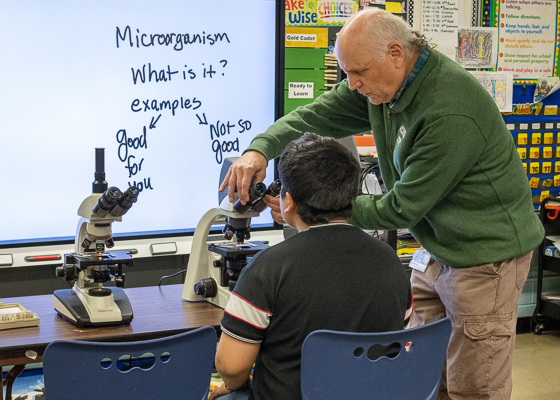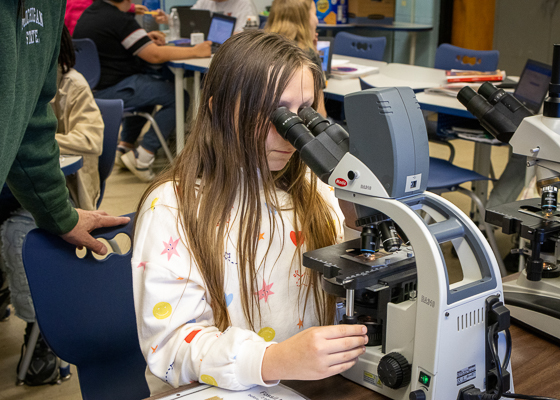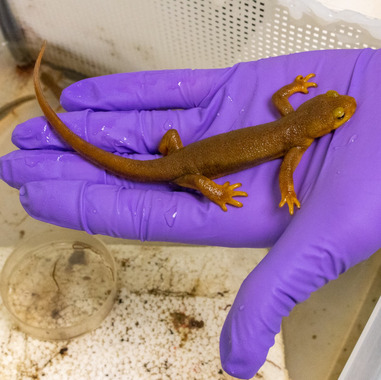MSU outreach sparks scientific curiosity in sixth-graders
In Mrs. Blondin’s classroom at Eisenhower Elementary School in Flint, Michigan, sixth-graders eagerly peered through microscopes, their eyes wide with curiosity. They weren’t just learning about bacteria, they were discovering a new way to see the world, thanks to a grassroots outreach initiative led by Dr. Jonathan Hardy, an associate professor in Michigan State University’s department of microbiology, genetics, & immunology.

What began as a simple idea—connecting university students with local schools—has evolved into a multi-year program that blends science education, mentorship and community engagement. Hardy’s mission is clear: to inspire underrepresented students to see themselves in science, and to do it through hands-on, screen-free learning.
The idea took root in 2020 when Hardy’s former student, Kayla Connor, shared her experiences doing outreach with Girl Scouts in East Lansing. Inspired by her enthusiasm, Hardy began to consider how similar efforts could be extended to local public schools, especially in communities like Flint, where students face systemic barriers to educational opportunity.
“There’s no formal mechanism at most universities to connect science students with public schools,” said Hardy. “I thought, wouldn’t it be great to have a website where you could sign up to do outreach, contact a teacher, and just go?”
Hardy spoke with MSU K-12 outreach coordinator Bryan Beverly, who already had connections in the Flint School District. He introduced Hardy to Kelley Blondin, and the project took off from there.
Hardy’s first outreach visit came together in 2022, when he and undergraduate student Asia Kirk brought a microscope and microbiology materials to Mrs. Blondin’s classroom. The students were captivated.
“They asked the same questions my 300-level microbiology students ask,” Hardy said. “I was very impressed with that sixth-grade class.”
The following year, Hardy returned with another student, a pre-med major named Pam Jones, who brought her own energy and confidence to the classroom.
“The kids didn’t want to let her go,” Hardy recalled. “They surrounded her (at the end of the session).”
This year, recent MSU human biology graduate Djeneba Diallo led the program.

“Participating in this outreach program taught me never to underestimate sixth-graders,” said Diallo. “Each of the students was eager to learn and curious about the unseen wonders that are microorganisms. I decided to participate in this program because I hoped it would give the students motivation to not only ask questions—which they did—but also give them the excitement to go to college like I did and find their passions, whether they’re in microbiology or any other field.”
Encouraged by the success of these visits, Hardy, Beverly, and Stephen Thomas of the Summer Research Opportunities Program are applying for a grant from the National Science Foundation. The proposal aims to place a high-quality microscope in every Flint elementary school and send trained undergraduates to lead a series of three outreach sessions per classroom.
The sessions include an introduction to microbiology, a field trip to collect water samples from the Flint River, and a final wrap-up featuring advanced microscopy techniques and colorful, genetically engineered bacteria. The program emphasizes tactile learning—students handle fossils, petri dishes and printed micrographs, with no screens or PowerPoints in sight.
“We want them to manipulate real instruments, to see real organisms,” Hardy said. “It’s physical, active learning. That’s what makes it stick.”
The grant, if awarded, would provide $730,000 over two years, funding a postdoctoral researcher and a graduate student from MSU’s College of Education to conduct an analysis of the program’s impact through surveys and interviews. Dr. Joe Krajcik from MSU’s CREATE for STEM Institute has also agreed to conduct an independent analysis.
Even if the grant doesn’t come through, Hardy is undeterred. “Nothing’s going to stop me from going back,” he said. “I’ve got the microscope, and I’ve got an open door at Mrs. Blondin’s class.

“We want to reach out to those students and see if we can get them interested in science.” he said, “and I think microscopes are a good way to start.”



